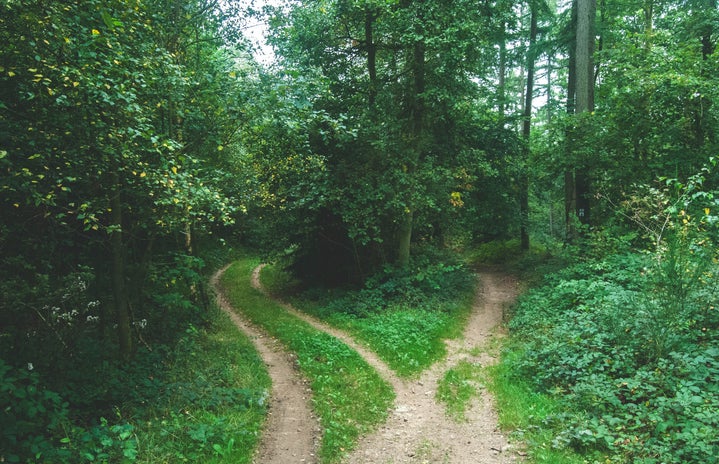I recently found myself in a position where I had to decide whether I was going to go on an exchange to a different country for six months. For a long time, I extensively contemplated both options: if I stayed at McMaster, I would risk not experiencing anything “new,” but if I traveled abroad during a pandemic, my own health could be at stake. In the end, I did not have to make an ultimatum, as McMaster announced they would be cancelling outbound exchange programs due to the growing concerns of COVID-19.
However, I was bothered by the idea that I probably would have never reached a final decision if it were not for the university’s choice to cancel the exchange program. I felt as though I had given up my life choices purely to chance, and I was only existing by going with the flow. Upon further reflection, I noticed I am a very passive person. I leave a lot of decisions up to others, follow along, and never offer to make a decision unless it is forced upon me. I would debate within myself what I wanted to eat for lunch, what music I wanted to listen to, and what movie I wanted to watch. I thought I had no control over my life. I was on autopilot, even though I did not choose to be.
I decided to do some research on why indecisiveness is a trait and how one can make decisions efficiently, or even make them in the first place. In 2000, psychologists Sheena Lyengar and Mark Lepper conducted a study on the motivations behind choice-making known as The Jam Experiment. Participants were subjected to a larger table with 24 different types of jams, and another smaller table with only six types of jams. Although the table with 24 jams garnered more attention, the majority of participants purchased from the table with only six jams. They made a choice and purchased from the smaller table, but only contemplated making a choice at the larger table. This study proves that when a person is given too many choices, they are less likely to make a decision.
The Jam Experiment explains my inability to make choices about food, music, or movies. I am presented with many choices, and I become overwhelmed with navigating through and pinpointing what I truly want. Yet, this study does not provide an explanation for when I have to make a decision between two options or, specifically, whether I should go on exchange or not.
I spoke with my family, friends, and peers about this issue and sought advice on how I could make this decision for myself. The more I repeated my stance, the more I noticed I was only repeating one thing: the negatives of both scenarios. I was fixating on the consequences of my choices, unconsciously preparing for the worst. I realized that because my decision-making skills completely neglected what I could be gaining, there was no way I could make any choice at all. As a result of this, I was avoidant of making a decision, because I didn’t think I would be very happy in either situation.
This made me realize my decision-making was practically based on how to avoid making the “wrong” decision when I should be focused on making the “right” decision. But, as I delved into this phenomenon, I questioned whether there was even a “right” or “wrong” choice in the first place. Think about it: every single choice or decision you have made in your life, regardless of how small or large, has led you to this moment. Perhaps one decision made about which university you would attend changed your life. Maybe your choice to befriend a particular person changed your life. Maybe even the smallest choice to watch a specific movie at a particular point in your life changed you completely. It is certainly overwhelming to think about; how could one possibly make a single decision with an infinite number of outcomes arising from it?
The key is to be aware that each of your options can lead your life down an endless pathway of both opportunities and downfalls, positives and negatives. It is unrealistic to believe there is only one “right” choice, as it entails that you will be 100% satisfied with the decision you make. Because there is no “true” path in life, embrace the uncertainty of life by making a choice, regardless of whether you’re sure of it or not, and committing to it.
Consider the scenario of purchasing something from the store with a return receipt versus the scenario of buying a non-refundable item. In the first scenario, you might ponder whether you truly need this item because you are given the choice to return it back to the store. However, in the second scenario, you are committed to keeping the item because you are not given the option to return it at all. My point is that if you train yourself to commit to a choice, you are automatically eliminating the option of ruminating on whether you made the right choice or not. Furthermore, you are choosing to trust in yourself to make the most out of a situation and that everything will fall into place.
I do not think there is a concrete guide to making life’s decisions; there is too much variability in how each of us think, let alone the vastly different decisions we are faced with on a daily basis. However, I believe that accepting that the “unknown” pathway a choice leads to has both costs and benefits, being able to commit to that choice, and changing perspectives to make the best out of every situation is fundamental in making any decision encountered. With more practice, you will also learn to be more open-minded to different situations, people, opportunities, and most importantly, feel in control of your life.


